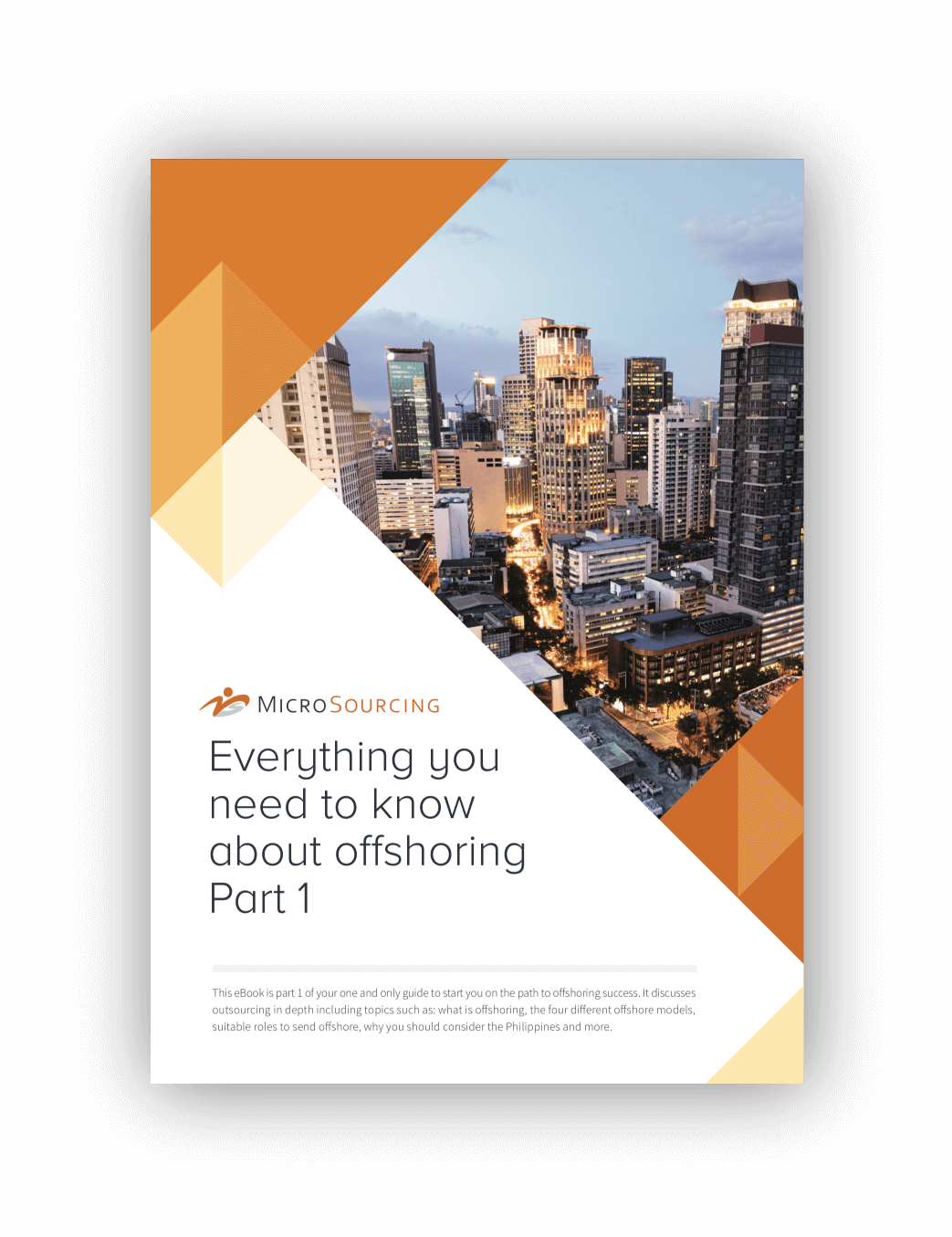Offshoring:
What you need to know
Offshoring is when you create an extension of your team or business in another country. For example, if you operate a business in the U.S., Canada or Australia, and you need to expand, rather than renting or buying a new premises or recruiting new employees locally, an option would be to source overseas talent to supplement your local capabilities.
How is offshoring disrupting business today?
Everybody’s talking about offshoring lately. And with good reason; it’s one of the most exciting opportunities in the market, and it’s disrupting businesses at every level.
Here are some ways you can use offshoring to disrupt your industry:
- You can cut costs significantly
- You can grow your team and scale faster
- You can remain competitive in a globalized market, and offer more affordable pricing to your customers
- You can compete in a bigger playing field if you’re a small-medium business
- And no matter how big or small you are, you can improve efficiencies and increase your profits.
If offshoring is an appropriate model for your business the best time to start offshoring is right now. You’re ideally positioned to join the disruption and get the benefits (before your competitors do).
The four different offshoring models: pros and cons
It’s easy to get confused when you hear the word, “offshoring”. That’s because, although the practice itself has evolved a lot over the past decade, the language we use to describe it hasn’t.
As a result, all the different offshoring approaches tend to get mixed in together. So, when someone says, “Oh, outsourcing... tried it... it didn’t work for me,” what they’re really saying is, “The type of outsourcing we tried wasn’t right for my needs.”
The reality is, there are four distinct offshoring models, and they couldn’t be more different from each other. And understanding them is key to choosing the right one for your business.
Which one - if any - is right for your business? Let’s explore the models in more detail.

Project-based outsourcing
This is where you pay a freelancer overseas to complete a project for you. You might use this offshoring model if you’re working with a limited budget, because an overseas contractor can be significantly more affordable than their local counterparts with the same skills.
The key thing to note here is that your freelancer is not full-time or dedicated to your business. While they complete your projects or retainer work, they’ll also work for other businesses and projects. Think of them as an overseas contractor.

PROS
- Often very cheap - great for startups
- It’s an ‘on-demand’ relationship that you can turn on or off
- It’s often quick and easy to find and hire people
- Occasionally, you’ll find a talented specialist to complete your one-off projects.
CONS
- You can’t control when, where, and how the work gets done
- They usually won’t have local knowledge, and there may be some cultural/ language barriers
- You’ll often need to source different freelancers for the same type of work, because your previous contact is unavailable
- If you want to change anything or work beyond the initial scope of the project, it’ll take longer and cost more.
THIS MODEL IS BEST SUITED FOR
- One-off projects that require specialist knowledge/skills
- Start-ups and micro businesses with very limited budgets
- Businesses that are willing to accept more risk or project delays to save money
- Businesses that don’t want or need full-time dedicated team members.

Traditional outsourcing (Business Process Outsourcing/BPO)
Traditional outsourcing is when you pay a provider to do absolutely everything. They recruit and manage your employees, handle all facilities and infrastructure, and manage business processes, productivity and work quality. In other words, you hand over the keys and tell your BPO to drive the whole thing.

PROS
- You don’t spend any time recruiting or managing staff
- Usually faster to get up and running than other offshoring models
- No local knowledge required.
CONS
- You have no control over your business processes
- Quality often suffers, as you have almost no input into how your offshore staff do their job
- More expensive than other offshoring options
- Not really cost effective unless you have quite a few staff
- Little operational integration with an onshore team can lead to an ‘us and them’ culture.
THIS MODEL IS BEST SUITED FOR
- Businesses that need a very fast turnaround
- Businesses that are more interested in minimizing their own workload than maximizing quality
- Short- to medium-term offshoring engagements
- Highly transactional tasks with little to no direct contact with your customers.

Incorporating your business offshore
This is where you physically go to another country yourself, and incorporate a company to function as an offshore division of your business. Where you do all the setup yourself including incorporation, facilities, security, infrastructure, telecommunications, recruitment, HR and payroll. Plus you manage day-to-day work quality and productivity.
This model of offshoring involves:
- Creating your own incorporated company in another country
- Paying tax in that country
- Finding an office
- Setting up computers, internet access, phones, furniture, etc.
- Researching and abiding by local labor laws
- Recruiting qualified staff members for each position
- With this approach to offshoring, you’re responsible for every element of hiring, managing, and running your business. Just as you are with your onshore team.

PROS
- You don’t spend any time recruiting or managing staff
- Usually faster to get up and running than other offshoring models
- No local knowledge required.
CONS
- You have no control over your business processes
- Quality often suffers, as you have almost no input into how your offshore staff do their job
- More expensive than other offshoring options
- Not really cost effective unless you have quite a few staff
- Little operational integration with an onshore team can lead to an ‘us and them’ culture.
THIS MODEL IS BEST SUITED FOR
- Businesses that have a genuine understanding of the culture/country they are offshoring in and are committed to long-term operations offshore so they can recoup their investment
- Larger businesses with a lot of time/money/resources to invest in setting up their offshore team.

Managed services offshoring
This is where you set up a dedicated team overseas, where labor is up to 70% cheaper. But you get a local specialist to handle facilities, recruitment, HR, IT support, legal knowledge and infrastructure, so you can focus on what you’re good at: day-to-day work quality and productivity.
You retain full control of your business processes, and fully integrate your offshore team into your business. Much as you manage your existing onshore team. Managed services offshoring means you get an experienced partner on the ground to handle basically everything your offshore team needs. And you supply the systems and processes to ensure high quality work and productivity. It’s up to you how you manage your offshore team.
This is the model that MicroSourcing uses.

PROS
- Costs are transparent
- You don’t need to be on the ground yourself to set up or manage your offshore team - it can all happen remotely
- Your partner will have the on-the-ground knowledge, connections and experience
- You get a dedicated team who works exclusively for your business
- You’re in control of your team’s tasks and processes
- Easy to scale up and down, and test the waters.
CONS
- It can take around six weeks from hiring to having a team ready to go, so it’s not instant
- Your team members usually won’t have knowledge of your home country, and there may be some cultural/language barriers (but you’ll have the operations provider’s support in managing this).
THIS MODEL IS BEST SUITED FOR
- Businesses that want a dedicated offshore team without spending months or even years setting up the infrastructure themselves
- Businesses that are proficient in creating efficient systems and processes to help save time and money
- Businesses that are keen to scale and grow, fast
- Businesses that want full-time positions filled and ongoing help with specific roles.
Which offshoring model is right for you?
While most businesses can benefit from some kind of offshoring, it’s definitely not the right model for every business. There are potential savings and benefits, but you need to commit time and effort to making it work. You need systems and processes so your offshore team can confidently work in your business. And you need to make sure your business is a good fit for the model.
What to consider when choosing the right model for you:
- Whether you’re planning to outsource a project or an ongoing task/process
- Whether you need full-time, part-time or freelance contract staff
- Whether you need local knowledge or access
- The level of skills and experience you need
- What type of infrastructure and resources you can provide
- How you plan to task and manage your team, and how they’ll interact and connect with your onshore team
- How much (and on what basis) you plan to pay your outsourced team members, whether it’s per project or per hour.
If you only need work for projects here and there, or you only need someone to work part-time for you, you don’t need a dedicated offshore team. At least, not yet. But if you need full-time, dedicated staff and want to partner with a trusted partner on the ground, it’ll be one of the best things you do for your business.
How much can your business save by offshoring?
A smart way to increase profits in your business is to cut your expenses in a way that won’t negatively impact your revenue. So look at your numbers. Find out exactly how your business is performing and what your biggest expenses are. If you’re like most businesses, you’ll already know, without looking, that your biggest expense is labor.
Offshoring has opened up an exciting new opportunity for many businesses to significantly lower their labor costs, without losing skills or impacting quality. Offshoring can also reduce your onshore fixed costs. A lot of business owners take fixed costs (like rent, facilities, electricity, and so on) for granted. But these costs definitely matter, especially if you’re trying to scale your business.

Why choose the Philippines as your offshore location?
The Philippines has a very similar culture to the U.S. Culturally, Filipinos are quite similar to Americans:
- They’re very loyal and honest
- They’re very accountable to their commitments
- Most speak fluent English
- They’re extremely hospitable
- And they tend to value their jobs highly.
Many businesses are concerned about offshoring to the Philippines because they believe the technology won’t be up to the high standards of Western countries. That’s a myth. In fact, the Philippines has very similar technology to the U.S.
The Filipino government invests heavily in infrastructure, particularly in the cities; Manila, for example, which is a home to a lot of large corporate facilities. The main thing to be aware of when offshoring to the Philippines is the typhoons that come through every year. This can cause outages for businesses that aren’t prepared. When looking for an offshore partner, look for one who has invested in world-class redundancy infrastructure and business continuity processes - a partner who can quickly and affordably move teams and facilities to entirely different buildings if necessary. This means maximum uptime for business operations, even during natural disasters.
